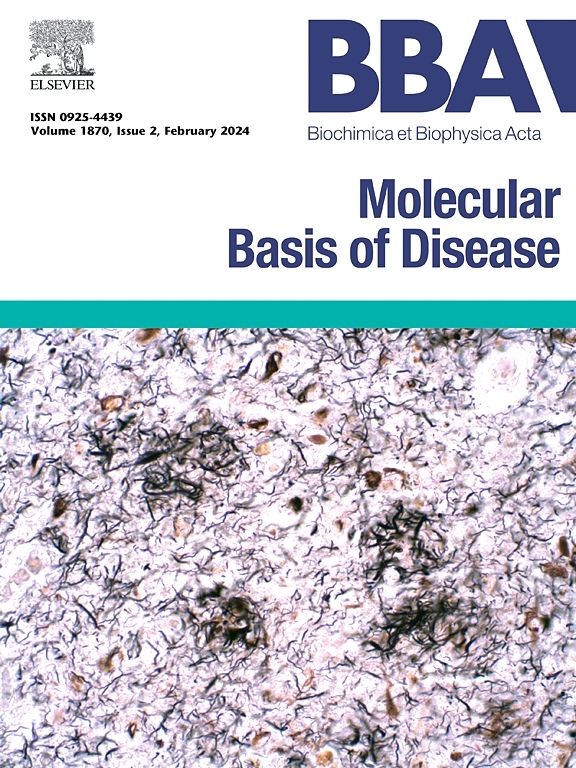致瘤性HNF4α在乳腺癌中通过募集p300/CBP激活SLC7A11抑制铁致细胞死亡
IF 4.2
2区 生物学
Q2 BIOCHEMISTRY & MOLECULAR BIOLOGY
Biochimica et biophysica acta. Molecular basis of disease
Pub Date : 2025-05-02
DOI:10.1016/j.bbadis.2025.167884
引用次数: 0
摘要
铁下垂是一种由脂质过氧化物积累引起的铁依赖性细胞死亡的新形式,近年来逐渐被认为是一种新的癌症治疗靶点。尽管铁诱导细胞死亡的确切机制尚未完全阐明,但本研究确定了其独特的作用。肝细胞核因子4- α (HNF4α)活性的降低在体外和体内均可增加乳腺癌(BC)细胞的铁下垂。机制上,HNF4α直接结合SLC7A11启动子,募集组蛋白乙酰转移酶p300/CBP,促进SLC7A11的转录。我们的研究表明,HNF4α在乳腺癌中对铁下垂至关重要,这可能为开发对化疗耐药的晚期癌症的新治疗方法开辟了可能性。本文章由计算机程序翻译,如有差异,请以英文原文为准。

Oncogenic HNF4α inhibits ferroptotic cell death through activating SLC7A11 by recruiting p300/CBP in breast cancer
As an iron-dependent novel form of cell death caused by the accumulation of lipid peroxides, ferroptosis has been gradually recognized as a new cancer therapeutic target in recent years. Although the precise mechanisms underlying iron-induced cell death remain incompletely elucidated, this study identifies its distinctive role. A decrease in hepatocyte nuclear factor 4-alpha (HNF4α) activity could increase ferroptosis in breast cancer (BC) cells both in vitro and in vivo. Mechanistically, it was found that HNF4α binds directly to the promoter of SLC7A11, where it recruits the histone acetyltransferase p300/CBP to promote transcription of SLC7A11. Our study shows that HNF4α is crucial for ferroptosis in breast cancer, which may open up the possibility of developing a new therapeutic approach for advanced cancers resistant to chemotherapy.
求助全文
通过发布文献求助,成功后即可免费获取论文全文。
去求助
来源期刊
CiteScore
12.30
自引率
0.00%
发文量
218
审稿时长
32 days
期刊介绍:
BBA Molecular Basis of Disease addresses the biochemistry and molecular genetics of disease processes and models of human disease. This journal covers aspects of aging, cancer, metabolic-, neurological-, and immunological-based disease. Manuscripts focused on using animal models to elucidate biochemical and mechanistic insight in each of these conditions, are particularly encouraged. Manuscripts should emphasize the underlying mechanisms of disease pathways and provide novel contributions to the understanding and/or treatment of these disorders. Highly descriptive and method development submissions may be declined without full review. The submission of uninvited reviews to BBA - Molecular Basis of Disease is strongly discouraged, and any such uninvited review should be accompanied by a coverletter outlining the compelling reasons why the review should be considered.

 求助内容:
求助内容: 应助结果提醒方式:
应助结果提醒方式:


